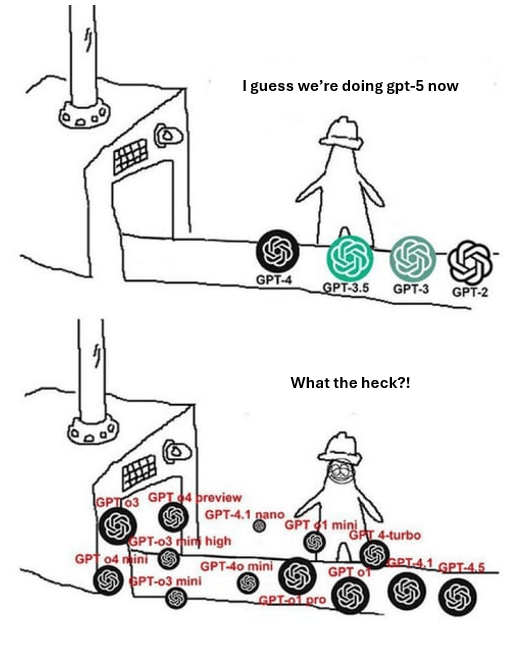- Lumian
- Posts
- Lumian Gen AI Newsletter Issue #61
Lumian Gen AI Newsletter Issue #61
OpenAI’s new models, ChatGPT x Social, Nari Labs Dia
Welcome to the 61st edition of the Lumian Gen AI Newsletter!

Every founder riding the AI wave believes their tool is irreplaceable. Until OpenAI pushes an update and the rug gets pulled.
We've entered an era where building on the wrong abstraction layer is terminal. One day you're the toast of VC Twitter, the next you're a Chrome extension feature that got baked into a model update. Tools for summarization, outbound sales, or voice synthesis, once seen as startups, are now footnotes inside a prompt. A force of nature collapsing superficial layers of value into the model itself.
Welcome to the Great Flattening.
The closer your product is to the core capabilities of the model (text, voice, image, retrieval), the faster it's commoditized. It’s not just about how fast you ship, it’s about where you build. And building next to the model’s center of gravity is like setting up shop in a floodplain.
But all is not lost.
The most promising founders in AI are doing something deeply uncool: they’re embedding into gnarly, domain-specific problems. Think insurance workflows, Medicaid reimbursement, customs clearance, safety audits. These aren’t buzzy. But they’re durable.
These startups manage workflows, handle compliance, and earn trust. They integrate so deeply that removing them would cause real organizational pain. That’s their moat. And when a new model releases? They just swap in the new capability, no reinvention required. This is the paradox of progress: the easier it gets to build a prototype, the harder it gets to build a business.
So, what survives? Not the dazzling tools. Not the hackathon winners. But the AI companies that look like operations firms. Like industry-specific SaaS. Like services businesses in disguise. They don’t sell prompts but actually deliver results.
The AI winners will monetize like professional services but scale like software. Their market isn’t apps but headcount. If an AI can replace a claims adjuster, that’s not $100/month SaaS, it’s $100K/year labor.
So how do you play to win?
You go deep, not wide.
You pick problems where hallucination is a liability.
You serve customers who care more about reliability than novelty.
You build in spaces where the job still matters, even if the output is automated.
In a world where models are abundant, the scarcest assets are distribution, trust, and embeddedness. The strongest AI companies won’t brag about being AI-first. They’ll be trusted partners in thorny industries and that trust will be their edge.
You don’t beat the model by outrunning it. You beat it by going where it can’t go alone.
Happy reading! 📚🤖🎵
In this week’s issue:
News Flash: OpenAI’s new models, ChatGPT x Social, Nari Labs Dia
Twitter Spotlight: Build An App In 3 Minutes
AI in Practice: AI Product Research Tools
Fundraising: The biggest deals in AI
Nerd Out: Technical and Business Content for Everyone
⏱️ News Flash
The 2-Minute Scoop to Keep You in the Loop
What’s the Buzz?
OpenAI launched GPT-4.1 and new agentic models o3 and o4 mini, signaling two big shifts in AI.
Breaking It Down
GPT-4.1 is a major upgrade: 1M-token context, better coding, and 26% cheaper than GPT-4o. o3 and o4 mini are agentic and trained to use tools while thinking, like web search or code execution.
Why It Matters
This marks a turning point: GPT-4.1 is smarter and cheaper. o3/o4 mini are something entirely new. AI is starting to think and act. Their naming could improve though!

What’s the Buzz?
According to The Verge, OpenAI is reportedly developing a social media platform likely tied to ChatGPT’s image generation as it eyes deeper engagement and data ownership.
Breaking It Down
OpenAI’s prototype adds a social feed to ChatGPT, giving users a space to post and share AI-generated content. Beyond expansion, this move is driven by the need for real-time data, user lock-in, and platform independence from rivals like Meta, X, and Google, who are already integrating chatbots into their feeds.
Why It Matters
A social network could give OpenAI the fresh data, engagement moat, and cultural relevance it needs to dominate the AI era.
What’s the Buzz?
Two undergrads from Korean startup Nari Labs dropped Dia, an open-source speech AI that rivals industry leaders without funding.
Breaking It Down
Dia, a 1.6B parameter TTS model, handles emotions, speaker tags, and even laughter with better performance than ElevenLabs and Sesame in key tests. It was trained using Google’s TPU Research Cloud, inspired by tools like NotebookLM.
Why It Matters
It’s a bold reminder that talent, access, and grit can now beat funding. AI is lowering the barrier to greatness.
🚀 Twitter Spotlight
Build an App in 3 minutes
This guy literally builds an app with Grok 3 in 3 mins
— Aadit Sheth (@aaditsh)
12:56 PM • Apr 22, 2025
🚀 AI in Practice
AI Product Research Tools
ProductRank - Understand how the top AI models promote products and brands
Brandlight - Improve your brand’s visibility on LLMs
🤑 Fundraising
The (AI) Intelligent Investor
OpenAI in talks to pay about $3B to acquire AI coding startup Windsurf
Mira Murati and Ilya Sutskever are both raising billions for their pre-product AI companies
🤖 Nerd Out
Technical and Business Readings
😜 Merci
Be Nice to AI!

If you were forwarded this newsletter, you can access more of our content by subscribing here.
Best,
Reply